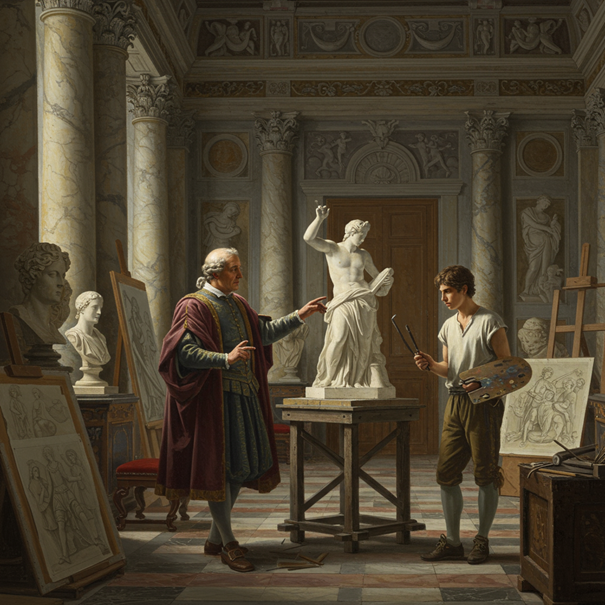The Hidden Hands That Shaped Art History
- Lavinia de Leonis

- Aug 10
- 3 min read

The Art Patron's Legacy
My dear readers, while we often stand in awe of the singular genius of an artist—the confident brushstroke of a master, the graceful curve of a marble form—it is easy to forget the powerful, often unseen, forces that made these masterpieces possible. Art does not exist in a vacuum. It is a dialogue, a dance between creator and commissioner. Today, I wish to take you on a journey through the grand galleries and silent palazzi of Italy to explore the profound legacy of art patronage, revealing how a handful of powerful families didn't just support the arts—they actively shaped the very course of art history itself. It is a story of ambition, power, faith, and a deep understanding that true greatness is often a collaborative masterpiece.
The Medici of Florence: The Architects of the Renaissance
To truly understand the power of patronage, one must first turn to Florence, the cradle of the Renaissance, and to the undisputed masters of this art: the Medici family. As bankers and rulers, their wealth was staggering, but it was their investment in culture that secured their eternal place in history. From Giovanni di Bicci to Lorenzo the Magnificent, the Medici saw art as a tool of power, a testament to their piety, and a symbol of their intellectual ambition. They didn't just commission paintings and sculptures; they created an entire cultural ecosystem. Imagine the young Michelangelo living in the Medici Palace, learning from ancient sculptures, or Botticelli and Leonardo da Vinci flourishing under their watchful eye. The Medici patronage created a virtuous cycle, attracting the greatest minds and cementing Florence's reputation as the epicenter of artistic genius.
The Borghese of Rome: The Patrons of the Baroque
The stage then shifts to Rome, a city forever altered by a new, more theatrical form of expression: the Baroque. At the heart of this revolution was Cardinal Scipione Borghese, a nephew of Pope Paul V, whose passion for art was as boundless as his wealth. The Borghese family understood that art was not merely a passive decoration but a dynamic, emotional experience. Scipione’s greatest protégé was none other than the young prodigy, Gian Lorenzo Bernini. It was under his patronage that Bernini created the masterpieces that now define the Borghese Gallery—works like the Apollo and Daphne and the Rape of Proserpina—where marble seems to defy gravity, capturing a single, explosive moment of emotion. The dramatic flair, the movement, the intense emotionality of the Baroque style was, in many ways, a reflection of the powerful and passionate taste of a single family.
The Barberini Legacy: The Glory of the Urban Plan
And what of the Barberini? This family, most famously represented by Pope Urban VIII, took patronage to a new level, transforming not just individual works but the very fabric of Rome itself. They were master urban planners, using art and architecture to glorify their dynasty and the Church. Pope Urban VIII commissioned Bernini to design the stunning Baldacchino in St. Peter's Basilica, a colossal bronze canopy that dominates the heart of the church. This commission was a powerful statement of authority and faith. The Barberini didn’t just fill their palaces with art; they used it to make a powerful, public declaration about their family's dominance and their vision for Rome as the spiritual and cultural center of the world.
The Symbiosis of Power and Creativity
The stories of the Medici, Borghese, and Barberini reveal something essential about the art world: it is a symbiotic relationship. The patron provided the financial stability and the artistic vision, while the artist, in return, created a lasting legacy for the family, immortalizing their power and prestige for generations. This partnership was often complex, a delicate balance of control and creative freedom, but it was from this very tension that some of the greatest works of all time emerged. The legacy of these powerful families is not just in the names of the museums and galleries that bear their names, but in the masterpieces that continue to speak to us across the centuries.
The Enduring Dialogue: Art and its Patrons
When we gaze upon a work of art today, we see not only the hand of the artist but also the shadow of the patron. The Renaissance and the Baroque were not just spontaneous outbursts of genius; they were meticulously funded, guided, and championed by individuals who believed in the power of art to shape the world. The next time you find yourself in a museum, I urge you to look beyond the signature and consider the story of the family who made it possible. You might just discover that the art you love is a dialogue between two great minds—the creator and the visionary who saw its potential.

.png)



Comments